Spain and Jamestown
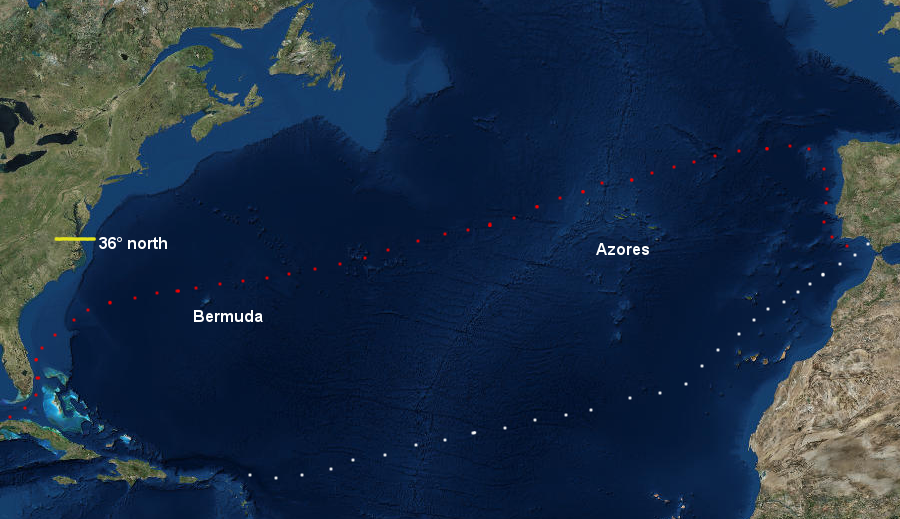
in the 1500's and 1600's Spanish ships sailed west from Seville (white dotted line) following the 23.5 north latitude of the Tropic of Cancer, and the treasure-laden ships returned home via Bermuda and the Azores (red dotted line) - so the North American coastline at Virginia's latitude of 36 north was of little interest
Source: ESRI, ArcGIS Online
Chrisopher Columbus arrived in the Western Hemisphere in 1492. Spanish colonization efforts were focused on Caribbean islands and Central America first, but in 1521 Pnce de Leon attempted the first settlemment on the North American continent. Scattered attempts continued, partially in response to French colonization attempts, for the rest of the 1500's. Though the Spanish were aware of the Bahia de Santa Maria/Chesapeake Bay, there was little urgency to sail that far north and create a new settlement until the French attempted to occupy a site near modern-day Jacksonvville, Florida.
The one attempt by Spain to colonize Virginia in 1570 received minimal support. A colony in the Chesapeake Bay was too far north from other Spanish settlements in the New World. Due to wind and current patterns, ships would have difficulty sailing south back to resupply in the Caribbean islands. Because Virginia was only marginally important, Spain allowed England to attempt to settle on Roanoke Island in the 1580's, and then at Jamestown in 1607, without a military response.
Spain's resources were stretched by efforts to occupy various Caribbean islands, New Spain (Mexico), Peru, and New Granada (Columbia). Spain got to the Caribbean first in 1492, but England, France, and the Netherlands were able to colonize islands later because Spain lacked the population to settle them all.
Spanish King Charles I was more interested in his other title as Charles V, Holy Roman Emperor. Asserting his claims to lands and authority in Europe was more important than developing colonies on the other side of the Atlantic Ocean. King Philip II followed his father to the throne, and he focused on wars against Muslims and Protestants in Europe.
Establishing Spanish dominance and spreading Spanish culture throughout the New World had value, including spreading the Catholic faith, but Europe remained the primary interest of the monarchs. They limited the resources sent to America. The Spanish royal court viewed American colonies as sources of wealth to finance more-important European adventures.
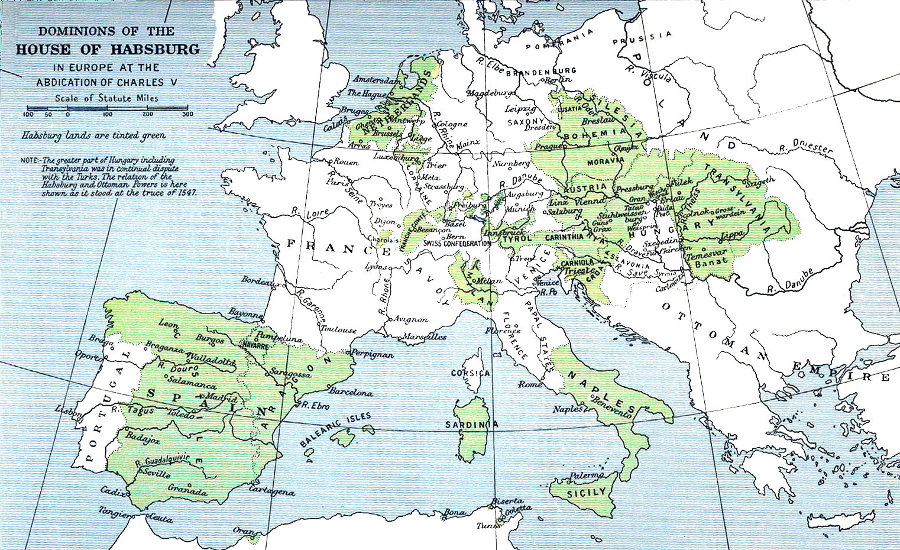
King Charles I of Spain was also Charles V, Holy Roman Emperor, and both he and his son Phillip II spent much of Spain's resources trying to dominate portions of Europe
Source: The Cambridge Modern History Atlas, A map of the dominion of the Habsburgs following the abdication of Charles V (refined and re-published on Wikipedia)
Thanks to Columbus' discoveries, Spain claimed all of North America. Its authority was by Right of Discovery. That claim was backed by an edict ("bull") issued by Pope Alexander VI and the 1494 Treaty of Tordesillas with Portugal.
Portugal had less interest in the Americas. It had already explored south and was on the cusp of discovering a path around the southern tip of Africa to India and the Spice Islands (now Indonesia). Portugal's focus was to expand its sea-based trade to the south.
Vasco da Gama finally sailed around the Cape of Good Hope and reached the Indian Ocean in 1498. The Portuguese diverted the trade in cinnamon, pepper, and other flavoring agents away from the land routes controlled by the merchants of Venice, who paid high transport costs through the Middle East controlled by the Ottoman Empire.
Access to the spices clearly would bring great wealth to the merchants of Lisbon, so investment in the Americas was of secondary interest. In 1500, a Portuguese fleet led by Pedro lvares Cabral was blown off course and discovered Brazil, but the ships simply sailed east again to get cargoes in India.1
The Treaty of Tordesillas and the Pope's endorsement divided the Americas, Africa, and the Indies between the only two nations with proven capacity to settle and trade in those areas. Portugal ignored the Americas initially while Spain exploited its discoveries.
In 1580, Spanish King Philip II gained control of Portugal's throne. Two more Spanish kings ruled that nation until 1640. Whether separate or under one common ruler, those two nations would not retain control of the New World without a contest.
The hardware of long-distance sailing ships was easily available to explorers and merchants in France, England, and the Flanders region that ultimately became the independent Dutch Republic. The software of seafaring knowledge and routes to new lands was also available to other countries; ocean-crossing pilots were willing to serve whatever nation was willing to pay for their expertise. The first to reach the New World, Christopher Columbus, was hired by the Spanish king and queen only after he failed to sell his proposal to other nations.
Spain concentrated on stripping the Caribbean islands of their wealth, then Central and South America. Those regions became the centers of colonial settlement, but most Spanish land grants were limited to the influential officials. There were not enough people in Spain willing to work as low-paid farmers in the New World, with little prospect of gaining control of land and future wealth.
Spanish colonists forced the Native Americans to provide free labor, sometimes as full-time slaves and sometimes for just periods of time through the encomienda labor system. Protestant nations highlighted a "Black Legend" emphasizing mistreatment. Within Spain, Bartolom de las Casas focused attention on the abuse of indigenous peoples, and obtained some legal protections from the king that were occasionally implemented in the New World.
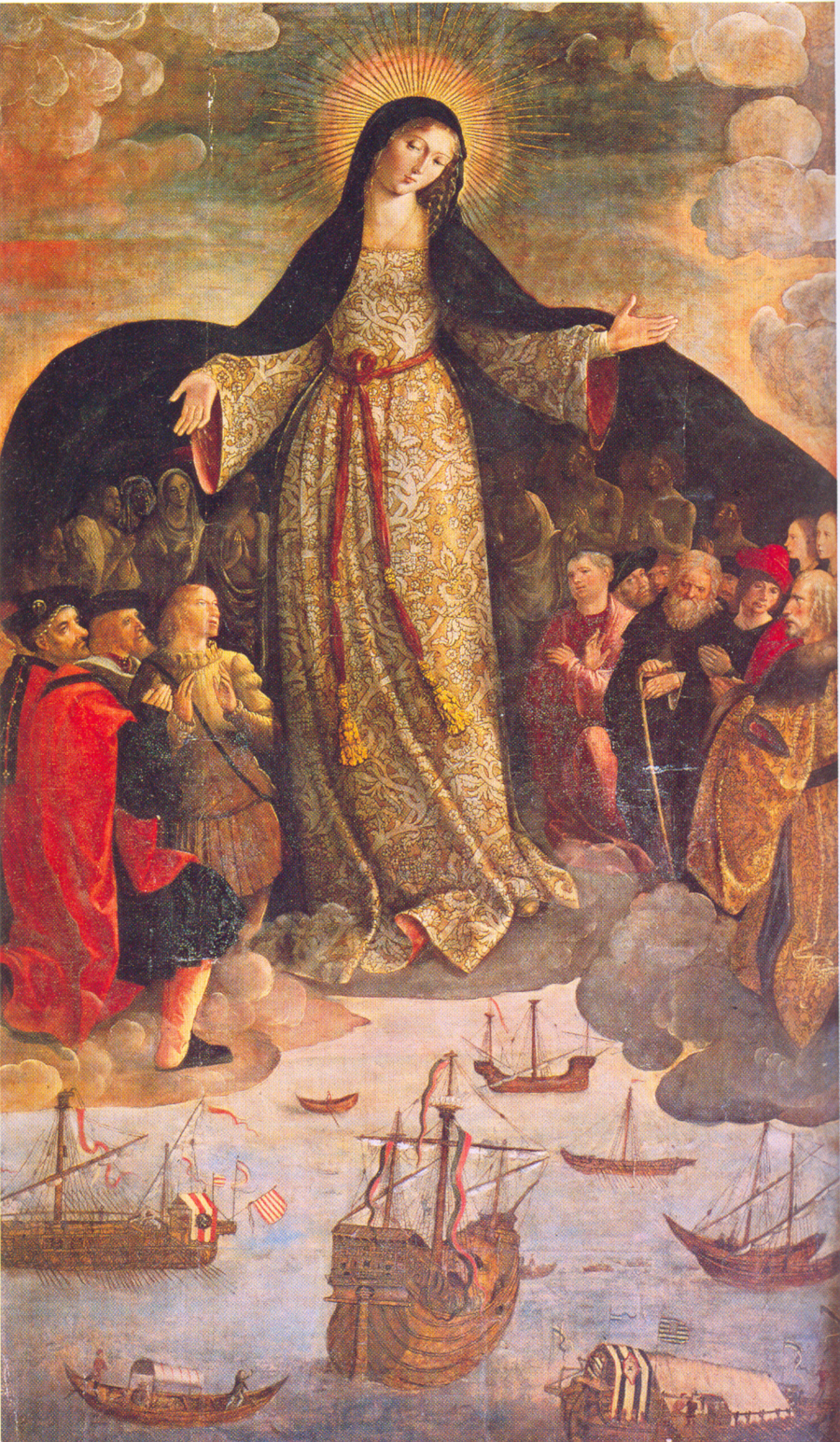
the first painting showing the discovery of the Americas highlights the Virginia Mary sheltering Native Americans, but the Black Legend of Spanish mistreatment reflected the demand for labor
Source: Wikipedia, The Virgin of the Navigators (by Alejo Fern ndez, 1531-1536)
Kings Charles I (1516-1556) and Philip II (1556-1598) obtained great wealth from Mexico and Peru, but chose to spend it on military efforts to control territory in Italy and the Low Countries (Netherlands/Belgium) rather than re-invest in its colonies. For Spain, the land north of the Caribbean was a low priority. There was not enough incentives or pressures for people to emigrate from Spain across the Atlantic Ocean, so Spanish occupation of the southeastern coast of the North American continent was minimal.
Spanish officials defined "Florida" as its land stretching north from the tip of the Florida peninsula towards the St. Lawrence River. Spain could not afford to build another fortified base in North America north of Puerto Rico. There were not enough incentives, and not enough colonists willing to leave Spain, to expand Spanish settlement north from the Caribbean.
Some adventurers tried. Lucas V zquez de Ayll n died during his attempt to start the San Miguel de Gualdape settlement in 1526 at Sapelo Sound, mid-way between modern Savannah, Georgia and Jacksonville, Florida. After just three months, the remaining colonists returned to Hispaniola and abandoned the first attempt to establish a permanent European colony in North America. It would be 81 more years before the English landed at Jamestown.2
Hernando de Soto's expedition, which started in 1539, demonstrated that Native American societies in North America did not have stockpiles of gold, silver or other resources to loot. Unlike the Aztec and Inca, the societies de Soto met were not organized as powerful hierarchies dominating large numbers of subordinates. There was no opportunity in North America for the Spanish to kill a pre-existing set of leaders and quickly establish control over large numbers of laborers accustomed to obedience.
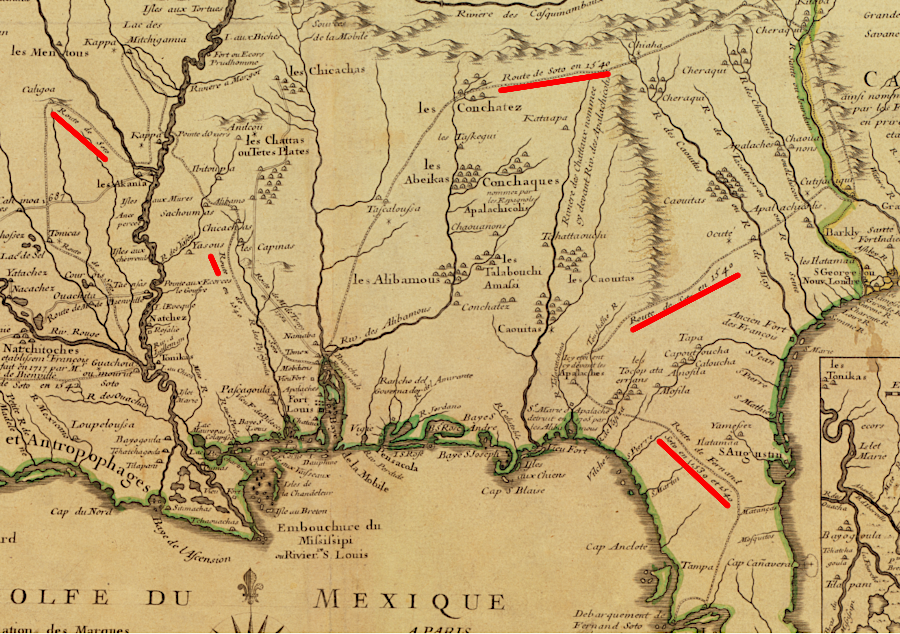
in 1718, a French map showed de Soto's route from modern Tampa to the Mississippi River
Source: Library of Congress, Carte de la Louisiane et du cours du Mississippi ... (by Guillaume de L'Isle, 1718)
The Atlantic coastline of North America offered no mineral wealth, had few concentrations of Native Americans who could be forced to labor for Spanish colonists, and was north of the normal route home for the treasure fleet. Virginia was far on the periphery of the core interests in the Caribbean, Mexico, Peru, and Colombia. There was only one abortive Spanish effort to establish a foothold in the Chesapeake Bay, at Ajacan in 1570.
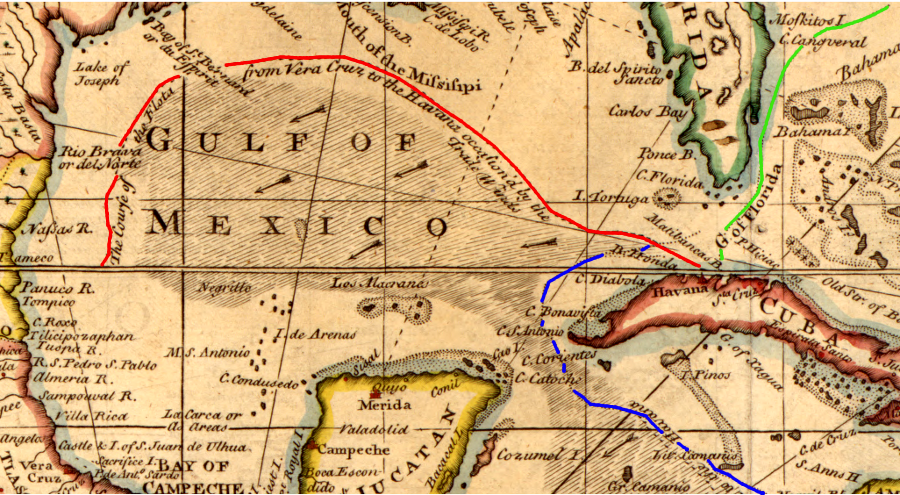
the annual treasure fleet that sailed to Spain assembled at Havana, combining ships that had left Vera Cruz loaded with Mexican silver and goods from Manila (red line) with ships that had left Panama loaded with Peruvian silver (red line) before the "Flota de Indias" sailed from Havana to Spain (green line)
Source: Library of Congress, A new and accurate chart of the West Indies with the adjacent coasts of North and South America (by Emmanuel Bowen, c.1720)
Spain left space in North America for France, England, or the Netherlands to fill with a colony, so long as it was far enough away from the Spanish treasure fleet.
The Spanish did confront rivals who built settlements close to the route taken by the treasure fleets that sailed past Florida to Spain.
The French tried to settle at La Caroline (in what today is Jacksonville, Florida) in 1564. In response, the Spanish killed nearly all of the French colonists and established St. Augustine in 1565. The Spanish did not want other European countries to establish bases on the southeastern coast of North America with pirates who might threaten the shipments of Mexican and Peruvian silver to Cadiz.
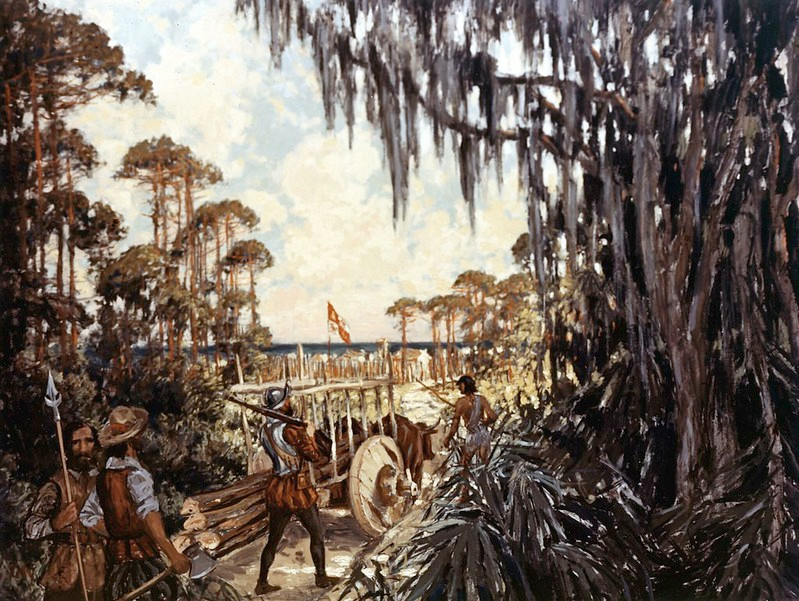
the Spanish founded the oldest continually-occupied colonial town in North America, St. Augustine, in reaction to a French settlement at what today is Jacksonville, Florida
Source: Federal Highway Administration, 1565 Saint Augustine (painting by Carl Rakeman)
The English sat on the sidelines for the first 80 years of the 16th Century, as the French and Spanish fought multiple times on the European continent. When the French contested with the Spanish for control of North America in the 1560's, the English avoided getting entangled.
Since Henry VIII had married the Spanish princess Catherine of Aragon in 1509, the English had been connected with the Spanish royal family. Both countries chose to fight the French in Europe rather than fight each other. Henry and Catherine's daughter, Mary, renewed the political connections between England and Spain when she married Philip II, the King of Spain.
After Henry VIII died, his only son Edward VI became his successor. Edward VI died six years later when he was just 15, but in that short time his regents and he shifted the country away from Catholic traditions. The Book of Common Prayer replaced the liturgy of the Mass, priests were allowed to marry, and Catholic symbols in churches were removed.3
When Edward VI died in 1553, Mary became England's first woman ruler. Like her Spanish husband Philip II, Queen Mary was a Catholic. She sought to redirect England back to Catholicism and became known as "Bloody Mary" for her persecution of Protestants.
Queen Mary died in 1558, too soon to complete a transformation of England back to the Catholic fait and alliances with Catholic nations. Her successor was her half-sister Elizabeth, daughter of Henry VIII's second wife Anne Boleyn. Queen Elizabeth I was a Protestant, and during her 45-year reign England solidified its status as a Protestant nation.
English foreign policy determined her marriage plans, and Queen Elizabeth I avoided any marriage to avoid allying with or antagonizing either Spain or France. She earned the reputation as a "Virgin Queen" because she never married, not necessarily because of her personal life. The presumption was that kings could be promiscuous, but a queen was allowed to have sex with only her husband. That way, the paternity of her child and heir would be reliable.
When Queen Elizabeth authorized Sir Walter Raleigh to start a colony in North America, she knew the colony would be located on land claimed by the Spanish. The timing of English colonization in North America, starting with the Roanoke Island efforts in the 1580's, was based on shifting international and religious rivalries in Europe.
A Cold War was underway in the 1570's and early 1580's. English ships were seizing Spanish ships and raiding Spanish settlements in the Americas. In 1585, England began assisting the Protestant rebels in the Netherlands who were fighting against Spanish control there.
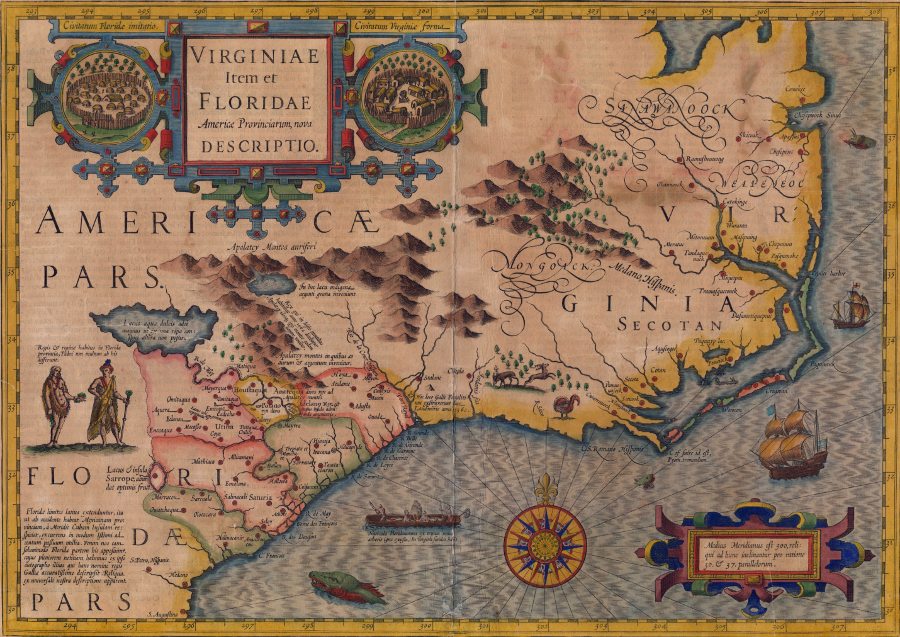
south of Virginia were Spanish and French settlements in what became South Carolina, Georgia, and Florida
Source: North Carolina Department of Cultural Resources, Virginiae Item et Floridae, Americae Provinciarum, nova Descriptio (published c. 1609)
The Spanish plotted to assassinate Queen Elizabeth and send an invasion force. Their plan as to place Mary, Queen of Scots on the English throne. She had fled from Scotland after an uprising to England in 1568. Though she was held in confinement, Catholics viewed Mary as having the appropriate ancestry from Henry VIII to be a legitimate alternative to Queen Elizabeth.
If Mary became Queen of England, she would restore the Catholic faith from the top down and end the shift towards Protestantism. In foreign affairs, she would ally with Catholic Spain, France, and Austria. Together they would fight Protestants in Europe, especially in the Low Countries and Germany.
In 1585, England expelled the Spanish ambassador after discovering his involvement in the assassination plot of Francis and Thomas Throckmorton. To eliminate the continuing threat, in 1586 agents of Queen Elizabeth ensnared Mary, Queen of Scots in what became know as the Babington assassination plot. A coded message from Mary, Queen of Scots supporting Queen Elizabeth s death was used to convict her of treason and execute her by beheading in 1587.
The plotters got support from Spain and other in the Catholic League. Their justification for murdering Queen Elizabeth was stated in one of the plot's letters:4
- ...by invasion of the Indies and by piracy, robbing the treasure and the wealthe of others, and sondry intolerable wronges for so great and mighty princes to indure, it was resolved by the Catholique league to seeke redresse and satisfaction
After the expulsion of the Spanish ambassador in 1585, Spanish King Philip II began preparations to invade England. In 1587, Sir Francis Drake made a preemptive attack on the Spanish fleet assembled at Cadiz, "singeing the King of Spain's Beard," but a full-scale armada was assembled in 1588. Spain planned for that fleet to escort an army assembled in France across the English Channel, but storms and the English fleet disrupted the Armada and blocked the invasion.
Spain assembled three more fleets in 1596, 1597, and 1599. None managed to attack England. A Spanish force did invade southern Ireland in 1601 and seized the town of Kinsale. After their Irish allies were unable to provide effective support, the Spanish were forced to withdraw.
Spain and England remained enemies until both Philip II and Queen Elizabeth I died. King James I of England and King Philip III of Spain ended the long conflict with the Treaty of London in 1604.
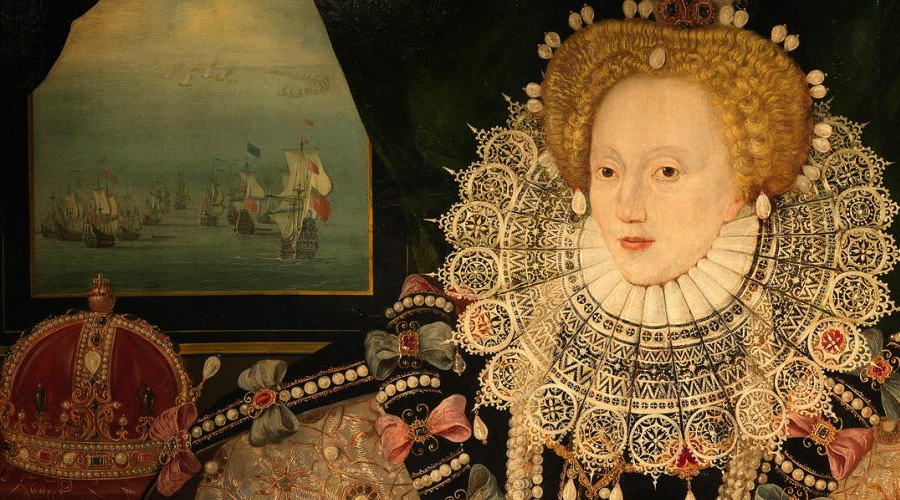
Queen Elizabeth I, with the English fleet engaging the Spanish Armada behind her
Source: Royal Museums Greenwich, The Armada Portrait of Elizabeth I
During the Anglo-Spanish War of 1585-1604, Spanish officials tracked English activities in North America through an effective spy network. England's failure to plant a settlement on the Outer Banks in the 1580's was no secret, nor was England's continued interest in creating a base in the Western Hemisphere after defeating the Spanish Armada in 1588.
The first English attempts to colonize North America did not occur until Protestants took full control under Queen Elizabeth and the English/Spanish alliance fell apart. English efforts to plant a colony in the 1580's failed. In the 1590's, English investors chose to pursue other opportunities and did not repeat Sir Walter Ralegh's efforts to create a permanent settlement in North America.
After James I and Philip III agreed to the 1604 Treaty of London, Spanish leaders avoided direct military confrontation with England in the New World. Spain had an ambassador in London again and could track English plans for renewing colonization, but chose not to renew the war by an attack.
That 1604 treaty opened the way for English colonies in North America, at least as the English interpreted it. The treaty was not crystal clear, and instructions to the Jamestown colonists warned that an attack by the Spanish on the new colony was to be expected. Conflict with France and the Dutch revolt for independence also occupied Spanish King Philip III. The same year in which Jamestown was settled, the Dutch navy destroyed a Spanish fleet at Gibraltar.
After learning of the Virginia Company's plans in North America, the Spanish worried about the potential of the English creating a privateering base that could threaten the treasure fleet. Don Pedro de Z iga, the Spanish ambassador in London when the Virginia colony was started, wrote back to the Phillip III, the king of Spain, on October 5, 1607:5
- It appears clearly to me now that it is not their intention to plant colonies, but to send out pirates from there, since they do not take women, but only men.
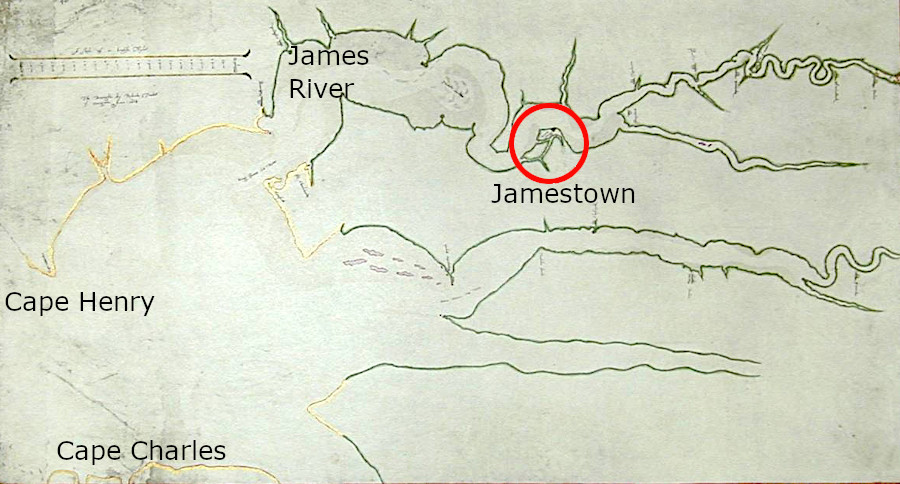
the English settled far upriver at Jamestown to minimize the risk of a Spanish attack
Source: Huntington Library, Tyndall's draughte of Virginia (by Robert Tindall, 1608)
Ambassador Z iga had an effective set of spies within the English government. He learned of the successful creation of Jamestown soon after Captain Christopher Newport arrived back in England in August 1607. Z iga sought an audience with King James I to object, and it was finally arranged after six weeks. That delay was long enough for Captain Newport to load two ships and prepare to sail back to Virginia with the First Supply without any interference by King James I.
Z iga tried to get King James I to abandon English colonization efforts in North America. The Spanish interpreted the 1604 Treaty of London to block English settlement in the "Indies," and claimed Virginia was included within that claim. Ambassador Z iga communicated the Spanish perspective that James I had more to lose than to gain by irritating Philip III of Spain:6
- this invention of going to Virginia for colonising purposes was seen in the wretched zeal with which it was done, since the soil is very sterile, and that hence there can be no other purpose connected with that place than that it appears to them good for pirates, and that this could not be allowed.
James I responded, perhaps with a smile, that he was not responsible for the private entrepreneurs who had formed the Virginia Company:7
- those who went, did it at their own risk and that if they came upon them in those parts there would be no complaint should they be punished.
The English failed again at Popham Colony at the mouth of the Kennebec River in Maine in 1607-08, but Jamestown hung on. The Spanish ambassador's recommendation was military action to destroy Jamestown:8
- I should consider it very desirable that an end should be now made of the few who are there, for that would be digging up the Root, so that it could put out no more.
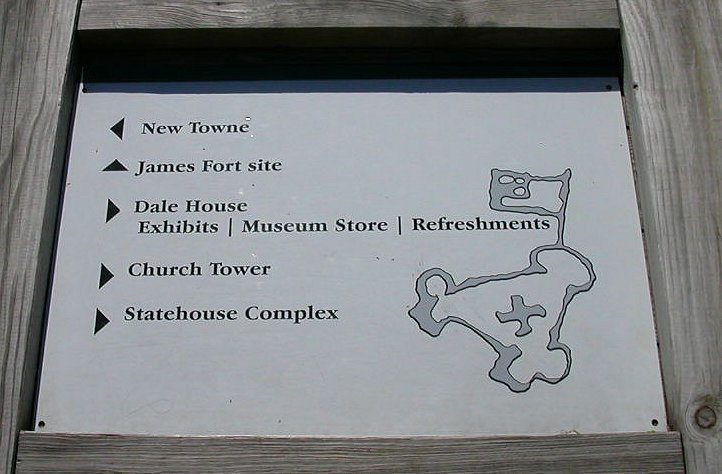
map of Jamestown fort (used on modern interpretive sign) originally obtained through a spy by Spanish Ambassador Z iga in London
The English colonists briefly abandoned Jamestown in 1610. Sir Thomas Gates loaded everyone onto ships and sailed down the James River towards the Chesapeake Bay, before running into the supply expedition led by Lord De La Warr. Investors in the Virginia Company then expanded to settle Bermuda, creating a new threat to the Spanish treasure ships sailing from Havana to Seville.
The Spanish continued to monitor the English colonization efforts but never chose to attack the Virginia colony. After learning that Captain John Clarke brought "100 cows, 200 pigs, 100 goats, seventeen mares, and 300 soldiers" to Virginia in 1611 and planned to send 2,000 new colonists, Phillip III did send a spy ship to evaluate English defenses at Fort Algernon.
Captain Diego de Molina sailed the La Nuestra Senora del Rosario to Virginia on April 13, 1611. Its cover story was that it was recovering artillery from a wreck, but the crew included an Englishman known as James Limry (or Limrick/Limbrecke).
When the Spanish ship arrived at Point Comfort, it determined the location of the shipping channel and stayed outside the range of the fort's guns. Captain Diego de Molina, ensign Marco Antonio de Perez, and the English pilot/interpreter/spy James Limry went ashore at Fort Algernon.
Captain John Clarke went out to the La Nuestra Senora del Rosario to guide the Spanish ship to safer anchorage, but they feared that he was trying to place the ship in a location where guns from Fort Algernon would be able to sink it. The Spanish seized Clarke and returned to Havana, leaving their three men behind.9
While a prisoner, de Molina smuggled information back to Spain about the colony's weak defenses at Point Comfort and Jamestown:10
- ...there is no expectation of aid from England for resistance and the forts which they have are of boards and so weak that a kick would break them down... a fortification without skill and made by unskilled men.
-
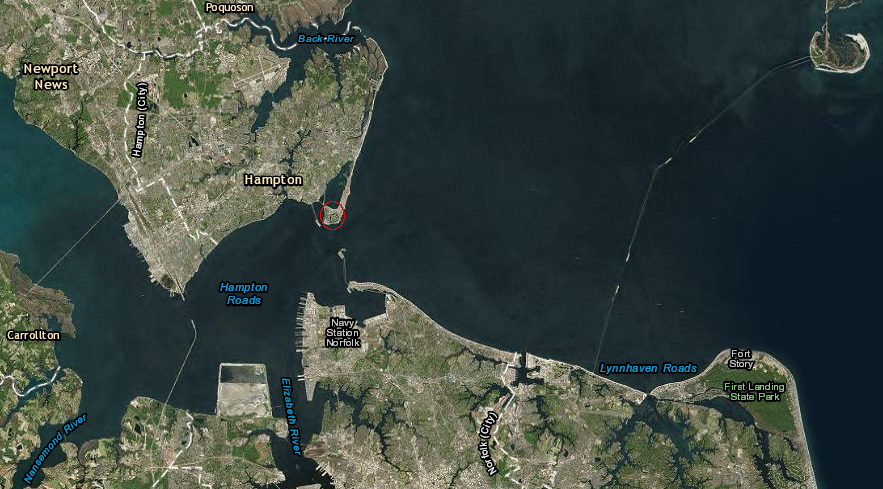
Fort Algernon, where three men from the Spanish spy ship La Nuestra Senora del Rosario came ashore, was located at the current site of Fort Monroe on Point Comfort (red circle)
Source: ESRI, ArcGIS Online
The Spanish carried John Clark to Madrid. He was interrogated for four years in an effort to make him into a spy, then finally exchanged for de Molina. Ensign Marco Antonio de Perez died while in Virginia, and the English pilot was hanged as a traitor. Clarke returned to sailing between England and North America, and was the pilot of the Mayflower in 1620. The Virginia Company gave him land, but he died soon after coming to Virginia in 1623.11
Spanish spies in London continued to report about the Virginia Company's supply expeditions, and regularly noted the weakness of the colony and the opportunity for the Spanish to destroy it. The English ambassador in Madrid was aware of Spanish interests and decisions, through his own network of informants. In 1613 the English ambassador wrote King James I that Spanish officials had assessed recently the threat of the Jamestown colony:12
- They have further the last week had a consultation concerning Virginia, but their resolution is not to stir therein until they should be better informed of the true state thereof. For that here [in Spain] by the advertisements that they have had out of England they are yet in a great hope that the business will fall of itself...
If the Spanish had considered it in their interest to destroy Jamestown, they would have needed to enhance their military capacity. Such an attack would break the peace established in the 1604 Treaty of London, sparking a renewal of war on the European continent.
Spanish official chose to avoid that risk. Even if the English managed to survive in Virginia, the Spanish suspected that it would struggle rather than thrive. There would be inadequate profits from the colony to justify England creating strong military capabilities in North America that might threatened Spanish interests in the Caribbean or Florida.
Spanish officials made a calculated decision, and no fleet was sent to obliterate Jamestown.

when the English initiated a colony at Jamestown in 1607, the Spanish priority in the Western Hemisphere was to extract more wealth from its islands in the Caribbean, plus settlements in Central and South America
Source: Wikipedia, Portal:New Spain
The Spanish failure to block England from creating settlements on the Atlantic Ocean coastline led to their loss of most of "Florida." About 150 years later on the West Coast, Spain used a different strategy to block the Russians from threatening California.
In the 1740's, Russian sea captains began hunting fur seals and sea otters in the Aleutian Islands, then moved south along the Alaskan shoreline. Spain was not passive as it had been when England started to do the same on the Atlantic Ocean coastline. Instead, after 1768 Spain created a string of 21 settlements in Alta California, from San Diego north to San Francisco Bay.
By that time, Spain had little public money to invest in those settlements. Franciscan missionaries, led by Father Jun pero Serra, raised funds and organized the labor to build churches and other public buildings. The church created communities that attracted some of the 300,000 Native Americans who lived in California.
The missionaries were responsible for converting those Native Americans so they adopted Spanish culture and the Catholic religion. Both religious and political officials shared the expectation that the Native American converts would support Spain in any conflict with Russian or European rivals.
Spanish military officials who traveled north into California, led initially by Don Gaspar de Portola, established only four presidios for army fortifications. Those fortifications housed soldiers and cannon to block enemy ships from entering key harbors at San Diego, Monterey, San Francisco, and Santa Barbara. The primary deterrent was the existence of Spanish settlements, occupying the land and establishing relationships with the local tribes. The British and the Americans sought to gain control over the Oregon territory, which was occupied by Native Americans but not by another recognized nation-state.
Despite the shift in authority after the Mexican revolution in 1822, the existence of Monterey, Santa Fe, and other Spanish-speaking settlements made a difference. They were effective at keeping the English, Russians, and Americans out of California until 1846.13
References
1. "Treaty of Tordesillas," Ayuntamiento de Tordesillas, http://www.tordesillas.net/en/descubre-tordesillas/historia/el-tratado-de-tordesillas; "Pedralvarez Cabral," Catholic Encyclopedia," http://www.newadvent.org/cathen/03128a.htm (last checked August 26, 2018)
2. "September 29," Today in Georgia History, Georgia Historical Society, http://www.todayingeorgiahistory.org/content/lucas-vasquez-de-ayllon (last checked April 3, 2016)
3. "Edward VI (r.1547-1553)," The Home of the Royal Family, https://www.royal.uk/edward-vi; "Edward VI (1537 - 1553),"British Broadcasting Company (BBC), http://www.bbc.co.uk/history/historic_figures/edward_vi_king.shtml (last checked August 25, 2018)
4. "Babington Plot," World Heritage Encyclopedia, http://central.gutenberg.org/articles/Babington_plot (last checked August 26, 2018)
5. "Z iga To The King Of Spain," October 5, 1607, in Alexander Brown (ed.), The Genesis Of The United States, Houghton, Mifflin and Company, 1891, pp.118-119, https://books.google.com/books?id=zUkOAAAAIAAJ (last checked July 4, 2015)
6. "Copy of a deciphered letter from Z iga to the King of Spain, dated London, October 8, 1607," in Alexander Brown (ed.), The Genesis Of The United States, Houghton, Mifflin and Company, 1891, p.121, https://books.google.com/books?id=zUkOAAAAIAAJ (last checked July 4, 2015)
7. "Copy of a deciphered letter from Z iga to the King of Spain, dated London, October 8, 1607," in Alexander Brown (ed.), The Genesis Of The United States, Houghton, Mifflin and Company, 1891, p.120, https://books.google.com/books?id=zUkOAAAAIAAJ (last checked July 4, 2015)
8. "Copy of a deciphered letter from Z iga to the King of Spain, dated London, October 8, 1607," in Alexander Brown (ed.), The Genesis Of The United States, Houghton, Mifflin and Company, 1891, p.122, https://books.google.com/books?id=zUkOAAAAIAAJ (last checked July 4, 2015)
9. Dennis Montgomery (ed.), 1607: Jamestown and the New World, Colonial Williamsburg Foundation, 2007, p.103; "Report of the Voyage to Virginia," letter from the Duke of Lerma to the Secretary Antonio de Arostegui, November 13, 1611, in Alexander Brown (ed.), The Genesis Of The United States, Houghton, Mifflin and Company, 1891, p.515, https://books.google.com/books?id=zUkOAAAAIAAJ (last checked April 1, 2016)
10. "Letter of Don Diego de Molina, 1613," printed in Lyon Gardiner Tyler, Narratives of Early Virginia, 1606-1625: Volume 5, C. Scribner's Sons, 1907, p.221, https://books.google.com/books?id=MrQnAAAAYAAJ (last checked April 1, 2016)
11. Dennis Montgomery (ed.), 1607: Jamestown and the New World, Colonial Williamsburg Foundation, 2007, pp.105-108
12. Edward Wright Hale, Jamestown Narratives, Roundhouse, 1998, p.xiv, https://books.google.com/books?id=Xl_RAAAACAAJ (last checked July 9, 2017)
13. "California Missions Timeline," California Missions Research Center, http://www.missionscalifornia.com/california-missions-timeline.html, "The California Presidios," California Missions Research Center, (last checked September 12, 2015)
Exploring Land, Settling Frontiers
Virginia Places











